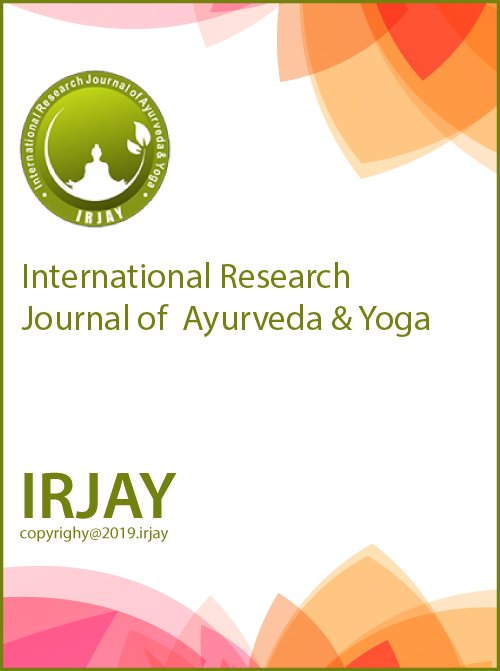Evaluation of Rodhradi Gana(Sushrutokta) in Yoni Roga w.s.r. to PCOS (Poly Cystic Ovarian Syndrome)
DOI:
https://doi.org/10.48165/Keywords:
Poly cystic ovarian syndrome, Yoni rog, Rodhradi gana ghana, Varun kanchnar ghanAbstract
Polycystic ovarian syndrome (PCOS) is a common endocrinopathy in women of reproductive age group and an incompletely understood enigmatic disorder of heterogenous nature. It starts appearing at 15 to 25 years of age and it may take years for its clinical presentation to appear. The incidence of polycystic ovarian syndrome is 4% to 22% of women overall and 50% of women seen at infertility clinics. Objective: - Therefore, the objective of this study was to evaluate and efficacy of Ayurvedic treatment (Rodhradi gana ghana and mixture of varun-kanchnar ghana) for PCOS patients. Material & Method: Total of 48 patients were screened at Rajvaidhya Prem shankar sharma govt. Ayurved chikitsalaya, Ambamata, Udaipur. 40 patients satisfied inclusion criteria, and signed informed consent and detailed medical history was recorded. Group-A (20 patient) Rodhradi gana ghana (3gm, 2TDS) for 90 days and Group- B (20 patient) Varun- Kanchnar ghana (3gm, 2TDS) for 90 days were prescribed to the patients. Result: The study was completed by total 40 female patients. There was a 76.74% result of group- A and 49.02% result of group-B, which is statically highly significant.
Downloads
References
Guzick D, Polycystic ovary syndrome, Symptomatology, Pathophysiology and epidemiology, Department of obstetrics and Gynaecology, University of Rochester, 1998, PP
Acharya YT, Charaka Samhita of Agnivesha, 5th Edition, Reprint, Varanasi, Choukhambha Prakashana, 2007, PP: 738
Tiwari P, Ayurvediya Prasuti-tantra evam Striroga, 2nd edition Chaukhamba Orientalia, Varanasi, 1990, pp;40 4. Shastri AD, Dravyasangrahniya, quotation-14,15, sushrut Samhita Edited with Ayurveda -tattva sandipika Hindi commentary, Chaukhambha Sanskrit sansthan, Varanasi, 2009.pg.184
Radhika SM, Evaluation of Lodhra (Symplocus racemosa Roxb.) Twak for mehaghna activity w.s.r. hyperglycemia- An experimental study, A dissertation submitted to the Rajiv gandhi university of health sciences Karnataka. 2009.
Sonil RK, Vihangesh Dixit, Raghuveer Irchhaiya, Harsh Singh , A REVIEW UPDATE ON SHOREA ROBUSTA GAERTN F. (SAL), Journal of Drug Delivery & Therapeutics, 2013.3(6), 127-132
Jadhav M, Sasikumar Menon, Sunita Shailajan, Ramnarayan (2013), An Anti-androgenic effect of Symplocos racemosa Roxb. against letrozole induced polycystic ovary using rat model, the Journal of Coastal Life Medicine. Ruia College, Matunga, Mumbai 400019, India, 10.12980/JCLM.1.2013C79
Wanjari P, LITERATURE REVIEW OF PALASH (BUTEA MONOSPERMA LAMK. TAUB),
International Ayurvedic Medical Journal (October November 2016) 1(1) 101-106
Chunekar K.C, Bhavamishra, Bhavaprakasha Nighantu, Com-mented Chaukambha Bharati Academy, Varanasi, edition-2010, Pp-524.
Subhashri Bindu, Satya Deo Dubey, Vedonmein Ayurveda, Chaukambha Vishwa Bharati, Varanasi, edi-1, Year 2010, pp.15.
Shastri K, Charaka, Charaka Samhita, Hindi commentary of Charaka Samhita, Vol I, Sutra sathana 4, Chaukhambha Bharti Academy, Varanasi, Reprint 2011.
Shastri K, Sushruta, Sushruta Samhita edited with Ayurveda- Tattav-Sandipica, Sutrasthana-37, Chaukhambha Sansthana, Varanasi; Reprint 2009, pp.182-190
Sharma P.C., Database on medicinal plant used in Ayurveda, vol –I, CCRAS, Delhi, Reprint 2002, pp 336
Sharma P.C., Database on medicinal plant used in Ayurveda vol –I, CCRAS, Delhi, Reprint 2002, pp 338 15. Ahad A, Ganai AA, Sareer O, Najm MZ, Kausar MA, Mohd M, Siddiqui WA, Therapeutic Potential of Oroxylum Indicum: A Review, Journal of Pharmaceutical Research and Opinion 2: 10 (2012) 163– 172
Borokar A. A., Dr. Pansare T. A., Plant Profile, Phytochemistry and Pharmacology of Ashoka (Saraca Asoca (Roxb.), De. Wilde) – A Comprehensive Review, International journal of ayurvedic & herbal medicine 7(2) March. -April.2017 (2524-2541)
Mihir K “antidiabetic activity of clerodendrum serratum (l.) moon leaves in streptozotocin-induced diabetic rats, asian j pharm clin res, vol 7, issue 6, 2014, 260-263
Panthari P: a review on active constituents, biological and therapeutic effects, Int J Pharm Pharm Sci, Vol 4, Suppl 5, 38-42
Imtiyaz Ahmad, Shariq Shamsi, Roohi Zaman, A
review on sour cherry (Prunus cerasus): A high value Unani medicinal fruit, International Journal of Green Pharmacy Jan-Mar 2017.
Guillermo Cásedas,a a, Bioactive and functional properties of sour cherry juice (Prunus cerasus Food Funct., 2016, 7, 4675
Farah I, “Phytochemistry and potential therapeutic actions of Boswellic acids: A mini-review, Asian Pac J Trop Biomed 2017; 7(6): 513–523
Reddy, A. K. ; Joy, J. M. ; Kumara, C. K. A. Lannea coromandelica: The Researcher's Tree, Journal of pharmacy research, 2011 vol.4, No. 3, P.P. 577- 579 ref. 24
Kumar B, In Ayurveda - A Critical Review, Ijpa- 4(9), Sept.-2015
Soni R.K, A REVIEW UPDATE ON SHOREA ROBUSTA GAERTN F. (SAL), Journal of Drug Delivery & Therapeutics; 2013, 3(6), 127-132
Imam MZ Musa paradisiaca L. and Musa sapientum L.: A Phytochemical and Pharmacological Review, Journal of Applied Pharmaceutical Science 01 (05); 2011: 14-20
Tabbassum P, Chandu DP, Archana B, Review of Varun (Creteava nurvala BUCH. HAM.) W.S.R. to Ayurvedic, Phytochemical and Pharmacological aspect IJRAPS. 2018Jul.18
Prakash L., A Text book of Dravyaguna Vijnana, Volume II, New Delhi: Chaukhamba Publications, 1st Edition, Print: 2014; p. 440

